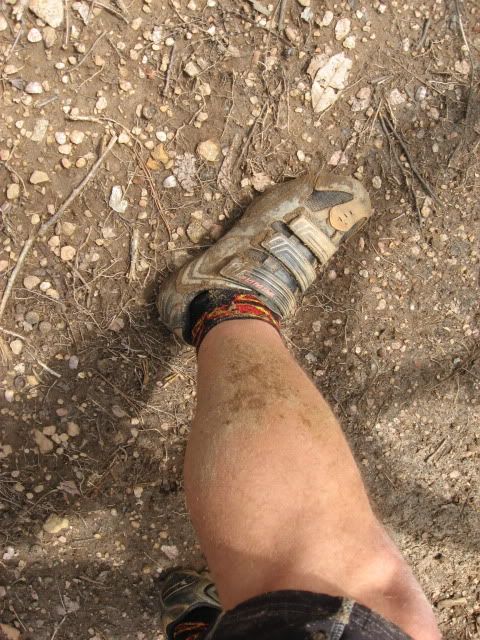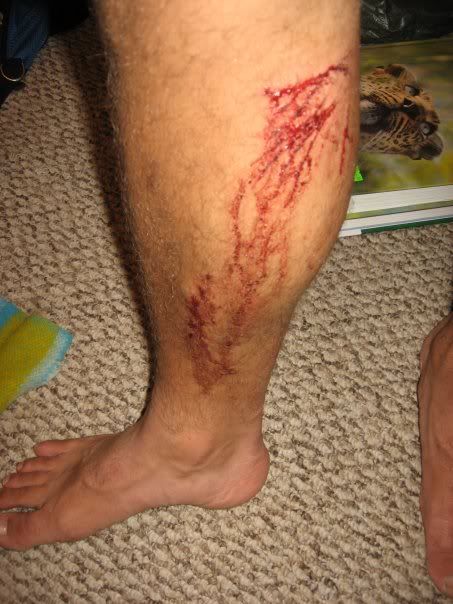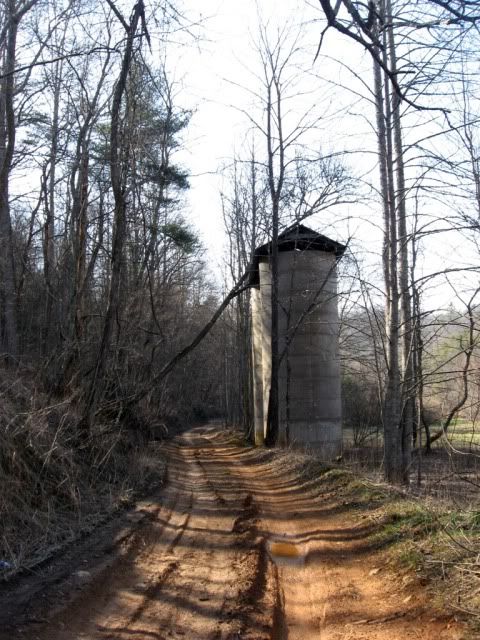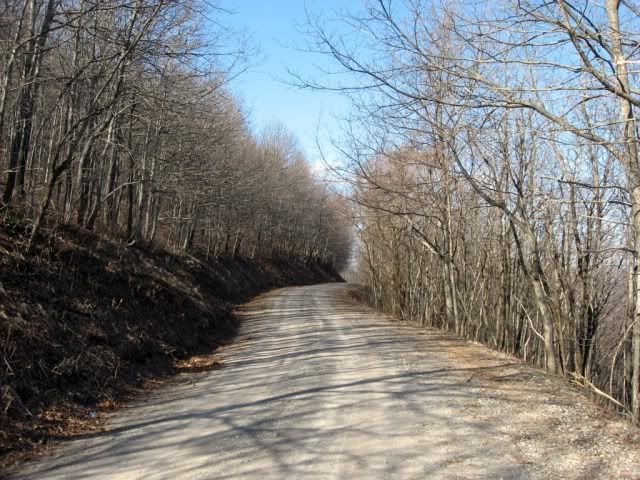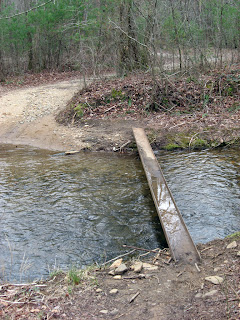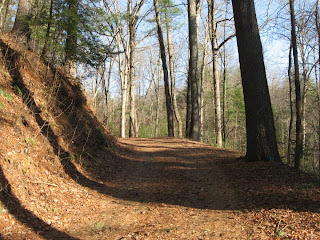This is my philosophy midterm paper, and I got a verbal “outstanding” and a 100% on it. (Hey, I did well, I think I deserve to pat myself on the back a little bit.) The last section of the paper deals with the question “Do material things really exist?” I think this is a question that is easily answered in all mountain bikers’ minds, and I use a short mountain biking illustration in my conclusion to tie it all together. If, as a mountain biker, you have not thought about this question or answered it to your own personal satisfaction, then read on. The first half of the paper discusses different views of knowledge and belief, which must first be understood before more specific philosophical questions such as “Do material things really exist?” can be addressed and answered.
Ha, all this talk of answers. I have come to realize that philosophy doesn’t even deal with answers. But that is a post for another time. So read on and enjoy my “outstanding” paper:
The Sutra of Gregory Heil: Midterm Exam
Knowledge
Over the course of the past several months, we have discussed in great detail several different philosophical views about knowledge, how it can be attained or discovered, and how it impacts belief. The views were complicated and varied, and the majority of the time they conflicted with each other. Reconciling all of these different views is impossible. Therefore, in order to develop a personal philosophical view on the topic, one must first understand the reasoning behind the different viewpoints, and then use discernment to decide on what the truth really is.
One of the first philosophers studied was that of Paul Feyerabend. Feyerabend in his piece entitled “Against Method” argued against the adoption of any one specific method of looking at the universe. Instead, he promoted the epistemological view of “anarchism,” which is basically a rejection of limiting oneself to a single way of viewing the world. Adhering to this worldview could create a more open minded individual who is willing to look at a particular issue or question from a multitude of views. However, the concept of anarchism, instead of truly freeing an individual from a confined form of thinking, creates yet another mental “box” by saying that having a specific worldview is bad.
When I refer to the term “box” as confined form of thinking, I am referencing a closed mindedness to other ideas. The heart of the philosophical pursuit is an examination of questions, and the different views from which that question can be analyzed. As was discussed in class, having a specific worldview in and of itself is not bad. The general consensus was that having a worldview but refusing to examine or try to understand other views was close-minded and irrational. If the specific worldview or epistemological method of discovering truth that an individual holds is sound, it should be able to handle a cross examination by other views. If, on the other hand, it is not sound, cross examination by a number of different ideas can reveal that. This would, and should, ultimately lead to the rejection of the original viewpoint.
Charles Sanders Peirce disagrees with the opinion that refusing to at least examine other beliefs is irrational. Peirce argues in his essay “The Fixation of Belief” that even if an individual was to avoid thinking about or experiencing anything that might possibly cause a change in their worldview, that he would be justified in doing so. The argument begins by acknowledging what many people say that if they believed certain things to be true, they must then believe that there is no life after death and there is no ultimate meaning or purpose in this life. Peirce then writes:
When an ostrich buries its head in the sand as danger approaches, it very likely takes the happiest course. It hides the danger, and then calmly says there is no danger; and if it feels perfectly sure there is none, why should it raise its head to see? A man may go through life, systematically keeping out of view all that might cause a change in his opinions, and if he only succeeds—basing his method, as he does, on two fundamental psychological laws—I do not see what can be said against his doing so. It would be an egotistical impertinence to object that his procedure is irrational, for that only amounts to saying that his method of settling belief is not ours. (Emphasis added.)
The author refers to this as “the method of tenacity.” The person in question tenaciously holds on to what he wants to believe. As the essay progresses, Pierce claims that while he has no problem with anyone who holds to such a method, in real life it really will not work due to the influence that people have on each other’s views.
Up to this point, I personally disagree with both of the philosophers that have been cited. I think the most logical choice is not a rejection of all methods of belief, but an examination of the options and an arrival at a specific conclusion. Basically, I’ve concluded that anarchism is not logical. However, I disagree with the opinion that all “methods of settling belief” are equally valid. This is what Pierce ultimately believes, and is firmly implied in the statement: “It would be an egotistical impertinence to object that his procedure is irrational, for that only amounts to saying that his method of settling belief is not ours.” I have concluded that this is also illogical. Different methods are different and therefore not all the same. In order to make sense of the matter, more philosophers must be consulted.
Many of the other philosophers that we moved on to examine spent their time promoting a specific epistemological method. In her writing entitled “Is Science Multicultural?” Sandra Harding points out in great detail many “Western” scientific ideas and inventions that actually originated in the East. She also points out that “we [in the west] are primarily based on Western Eurocentric white-male thought” (Quotation taken from notes). Harding’s main point is that Western thought is not the only scientifically accurate view point. The East is just as scientifically valid. Patricia Hill Collins also rebels against the standard of white-male dominated epistemology. In her mind, personal experience is the best, and at times the only, lens that the world should be viewed through. Ayatollah Murtaza Mutahhari examines the scientific, philosophical, and religious points of view. He concludes that science is incomplete as worldview because “one [cannot] determine by experiment whether the universe has a beginning and an end or is limitless in time.” There are questions that science can’t answer. Mutahhari concludes that a philosophical worldview is deficient, because it doesn’t actually give answers to any questions. Religion is then set forth as the worldview that can answer the great questions and provide a foundation for life. Mutahhari’s religion of choice is Islam, also known as the “world view of Tauhid.”
My conclusion based on all of this study is simple and yet complicated at the same time. I have concluded that not just one specific epistemological method can suffice in the search for truth. Different methods are applicable in different situations. Personal experience may be the best epistemological method to use when looking at people’s lives. Science is applicable when attempting to discover information about the natural world. Philosophy is applicable when trying to think rationally about why the world is the way it is. A religious worldview is necessary in order to give answers to the questions posed by science and philosophy, such as “Who or what is God?” Yes, religion can only talk about who/what is God, what is he like, how should we live, and etc. To avoid circular reasoning, the question of “Is there a God?” can only be answered by scientific and philosophical methods. I personally believe that science and philosophy answer the question “Is there a God?” affirmatively (although I will not go into great detail about that here). Thus religion enters onto the scene. So, not just one worldview can suffice. To obtain a holistic view of truth, several epistemological methods must work in harmony. However, not all methods are equally valid. Some methods lie in direct contradiction to each other, especially when different specific religious views are brought onto the scene. Great wisdom and understanding must be used in order to discern between all of these different views and methods. But the underlying mechanics of it all rest in philosophy and science.
Five Questions
Philosophy is concerned primarily with asking questions and less with finding solid, concrete answers to those questions. From the texts that we have studied over the past 2 months, I have identified five important questions that we should all ask ourselves. They are: do material things really exist; are there non-material things that exist; is everything one, or do we exist merely as individuals; is science the best way to attain knowledge of the world; and can enlightenment to a state above the ordinarily perceived world be achieved? The question “Are there non-material things that exist?” is important because knowing whether or not we can actually think and reason is vital to the practice of philosophy itself. Also, this naturally leads into the question “Is there a God?” which may be the greatest philosophical question of all time. The question “Is everything one, or do we exist merely as individuals?” boils down to a head-to-head confrontation of Eastern philosophy and Western philosophy. There are many major differences, and trying to understand them and/or reconcile them is vital. The query “Is science the best way to attain knowledge of the world?” can primarily be viewed as a critique of the Western philosophy examined in the previous question. It also deals with the basic question addressed in the first section of this essay: “Which epistemological approach is best?” “Can enlightenment to a state above the ordinarily perceived world be achieved?” is relevant due to several of the works which we read by people claiming that they have, in fact, traveled to higher worlds or achieved exceeding levels of enlightenment as to promote them to a plane higher than the rest of humanity. Knowing whether or not this is possible (and if it is, how to attain it) is crucial to how we approach life and learning.
All of the aforementioned questions are very important. However, based on the readings that we have covered so far this semester, the question of “Do material things really exist?” is the most important. We read many works that dealt with this specific issue. The philosophers were divided all across the spectrum, all the way from thinking that nothing material exists whatsoever and all that exists are perceptions, all the way across to the only things that really exist are the material. For the remainder of this paper, the fact that nonmaterial things exist is more or less taken for granted.
Darwinian scientists, however, are of the firm opinion that all that exists is the real world. They believe only in natural law, and form one extreme on the spectrum of materialistic debate. According to Charles Sanders Pierce in his “The Problem of Method,” science’s
. . .fundamental hypothesis, restated in more familiar language, is this: There are Real things, whose characters are entirely independent of our opinions about them; those Reals affect our senses according to regular laws, and though our sensations are as different as are our relations to the objects, yet, by taking advantage of the laws of perception, we can ascertain by reasoning how things really and truly are; and any man, if he have sufficient experience and he reason enough about it, will be led to the one True conclusion.
All the rest of the philosophers examined below are much more skeptical about the reality of what is seen and perceived. Atheistic Darwinian naturalists thus provide the most materialistic of views to breed skepticism from.
Surprisingly similar to the view of the naturalist is the Eastern view of the Upanishads. The similarity lies in the high priority placed on physical things. The Upanishads believe that “Thou Art That.” God is inside of the individual, and the individual is God. God is also above the individual and dictates the individual’s life. In order for the individual to know God, he must come to know himself. God is also in everything else. Since God is inside the individual and inside everything and everyone else, the individual is by extension a part of everything around him. As a result, one wants to treat the world with great care. All is one: many threads in the fabric of God, but also at the same time not. Because of this, the material has immense value and importance.
The material world is simply a crude extension of a higher world, at least, according to Plato. Through “The Parable of the Cave,” Plato tells about “the world of forms,” and sheds light on enlightenment. In Plato’s mind, the world of forms is the true world, with very distinct objects. These objects are projected into the world which the average human being interacts with. These projections are but mere shadows, crude and indistinct. In order to truly achieve enlightenment, one must journey from what is commonly considered the normal world, to the highest level of the world of the forms. The catch is, if one were to truly achieve this enlightenment and come back down and share it, that person would be considered insane because of the total lack of comprehension by anyone else. They would not be able to relate to this great enlightenment.
Crazy Horse believed in a world of forms that was much the same as that of Plato’s. He stepped it up a notch though, and believed that he could move between this world and the world of forms at will. Many people attribute his miraculous safety in battle to this ability to move between the two worlds. This ability to move between the two worlds would only be useful if they resembled each other like Plato’s concept of the upper world. Divided by several thousand years and several thousand miles, they both held congruent views about the essence of the material world.
Radically different from the views of Plato and Crazy Horse, George Berkeley believed that only perceivers and perceptions exist. He realized that that a person can be fooled by their senses. Because of that, there must be at least two perceivers perceiving the same thing for it to be real. According to Berkely, if there aren’t two perceivers, the perception cannot be trusted. David Hume takes it a step further. He believes that there are no perceivers, just perceptions. According to Hume, everything that we think are material things are simply jumbles of perceptions, floating around in who knows what, in a constant state of flux. He puts it this way: “I may venture to affirm of the rest of mankind, that they are nothing but a bundle or collection of different perceptions, which succeed each other with an inconceivable rapidity, and are in a perpetual flux and movement.” As an extension of this, Hume proposes that things we recognize as always having the same characteristics are simply a bundle of perceptions that happen to continue to occur together to give us concepts of objects. That does not go as far as to say that it is proof that those objects exist. This is known as the “bundle theory of knowledge.” In my opinion, David Hume just wanted to do whatever he pleased, and so he decided that he could not really prove the existence of anything. He was unsure of the world. If he had been a few centuries later, he could have latched onto the views of the Darwinists and, taking them to their logical philosophical end, achieved much the same result.
After all of this reading and discussion,
my personal opinion about the nature of reality has not changed. Sure, maybe nothing really exists and it is all perceptions. But even if everything is just a perception, one perception of a rock can really hurt my perception of me when it falls off of its perception of a
mountain bike during the perception of an afternoon ride. Philosophically, perhaps there is a big difference.
However in the way we live our lives, would be no difference whatsoever. I believe it is most logical to live with a belief in both material and the immaterial, and the idea that one can impact the other. Until a view with real substance which logical people called “proof” or even “evidence,” I am going to continue to live my life much the way I have been. Because really, where is there any evidence in what has been said for the insubstantiality of the tangible world? I submit that there is next to none.
Read more...



